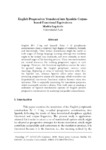Mostrar o rexistro simple do ítem
English Progressives Translated into Spanish: Corpusbased Functional Equivalents
| dc.contributor.author | Izquierdo, Marlene | |
| dc.date.accessioned | 2016-07-15T08:35:35Z | |
| dc.date.available | 2016-07-15T08:35:35Z | |
| dc.date.issued | 2008 | |
| dc.identifier.citation | AEDEAN 2008, 31: 829-845 ISBN-978-84-9749-278-2 | |
| dc.identifier.isbn | 978-84-9749-278-2 | |
| dc.identifier.uri | http://hdl.handle.net/2183/17096 | |
| dc.description.abstract | [Abstract] English Be+ V-ing and Spanish Estar + G periphrastic constructions share a relatively high degree of similarity, formally and functionally. Their formal resemblance might be useful at early stages of foreign language learning, although this similarity ought to be looked into cautiously, and even critically, at more advanced stages of the learning process. These two constructions are central resources for realising progressive aspect in each language. However, this functional equivalence cannot be taken for granted always; the English periphrasis conveys other meanings, displaying an array of semantic functions wider than the Spanish one, whereas Spanish offers other means for conveying progressive aspect and meanings, which overrides any (hypothetical) one-to-one functional relation between these two resources. This is especially interesting for translation purposes,which necessarily involve a choice. This study aims at creating a collection of Spanish translational options of English present progressive constructions by analysing real parallel concordances. | |
| dc.language.iso | eng | |
| dc.publisher | Universidade da Coruña | |
| dc.title | English Progressives Translated into Spanish: Corpusbased Functional Equivalents | |
| dc.type | info:eu-repo/semantics/conferenceObject | |
| dc.rights.access | info:eu-repo/semantics/openAccess |






